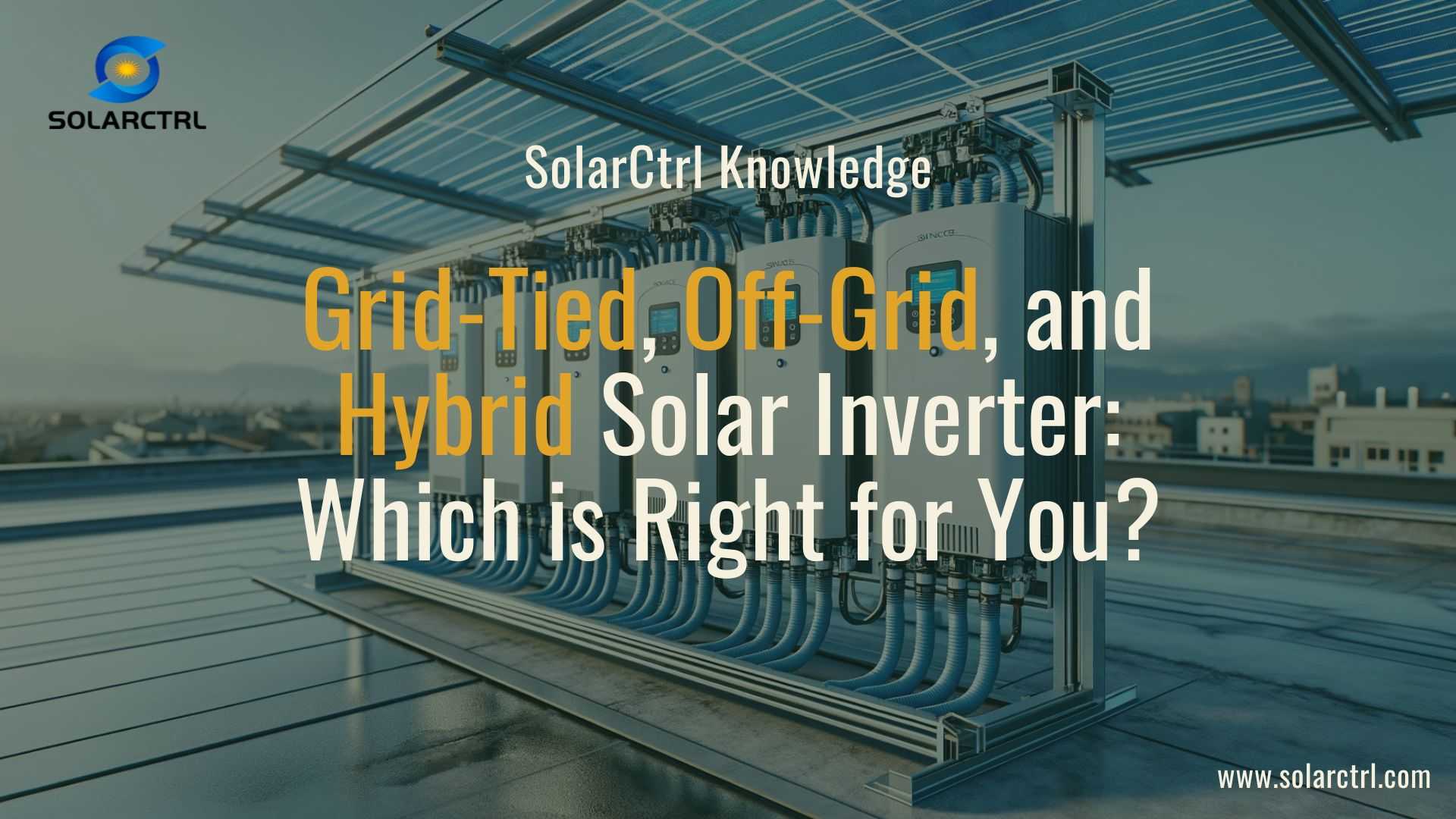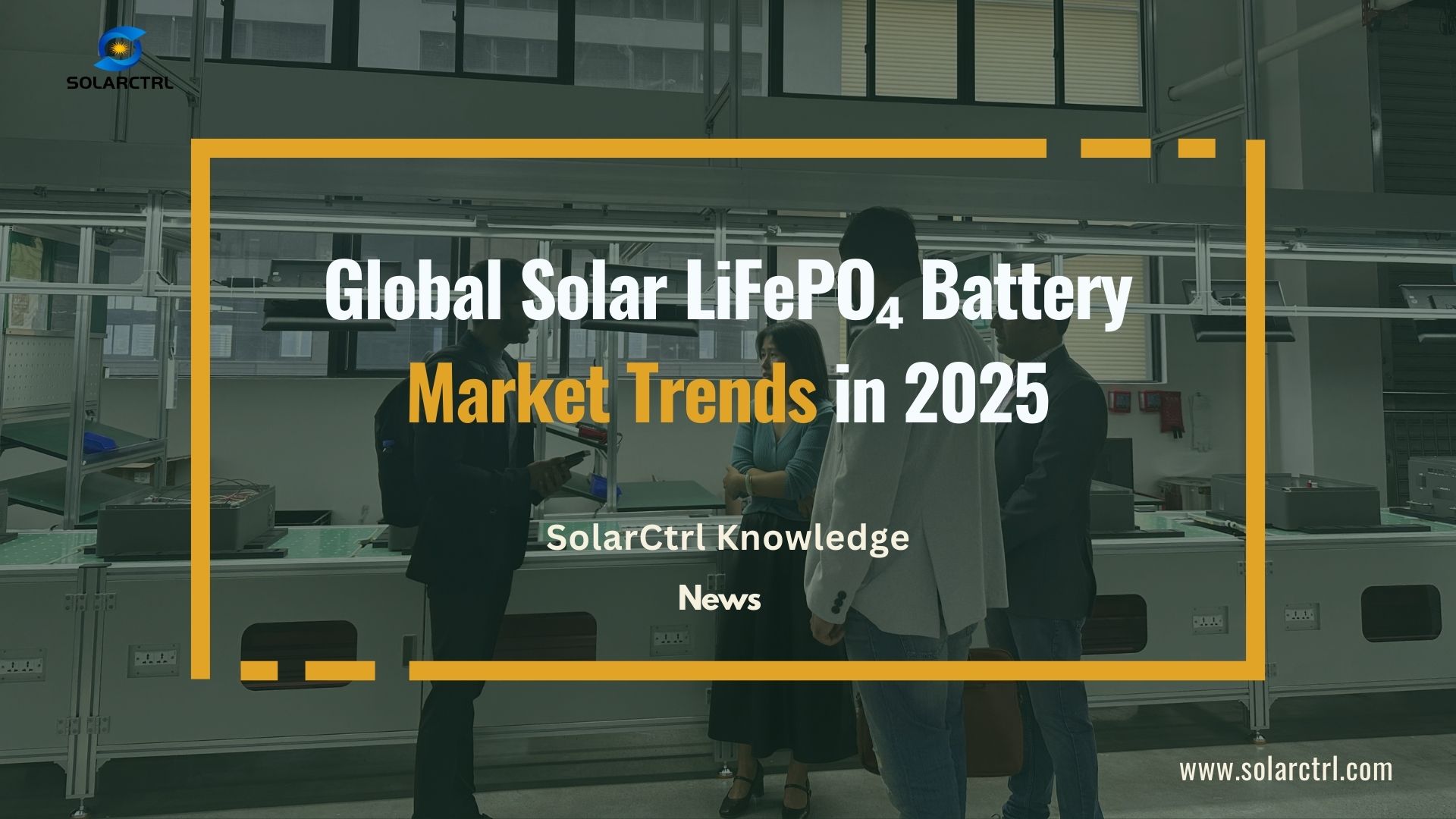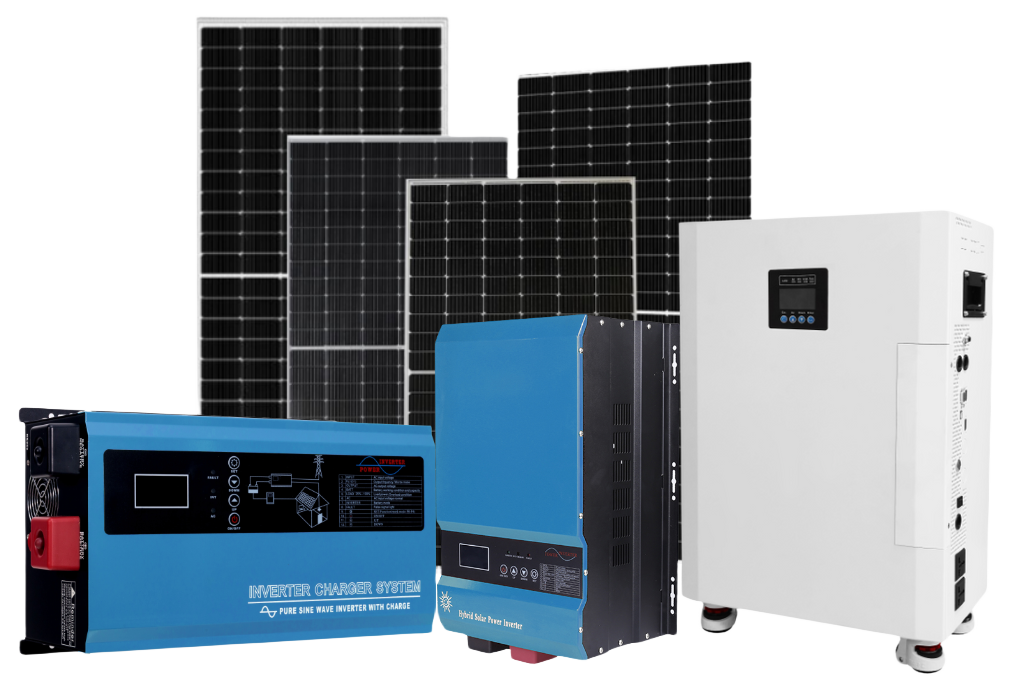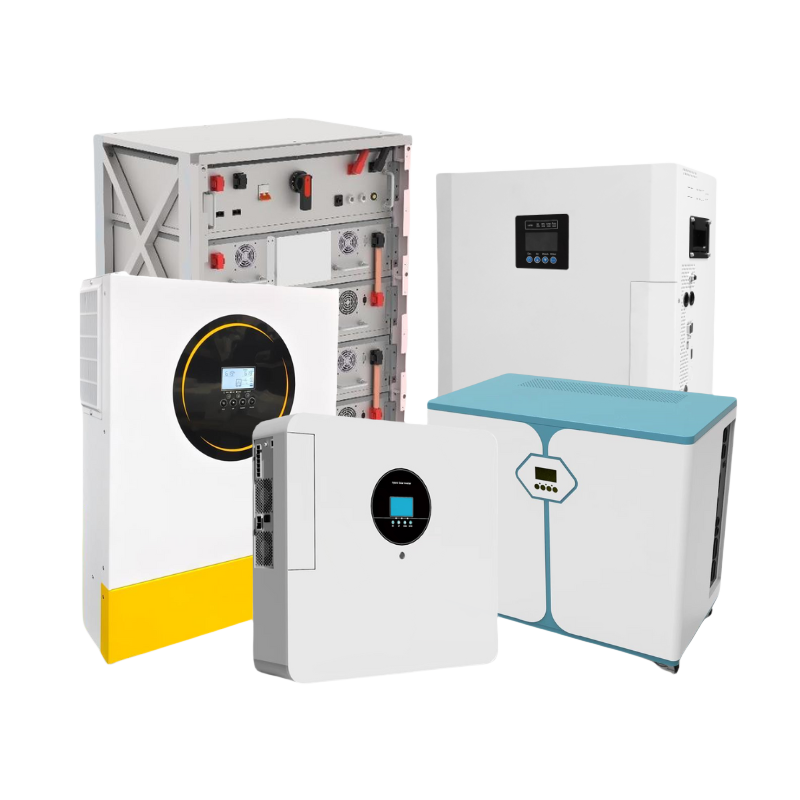Introduction
The decision to adopt solar energy involves several considerations, one of which is selecting the right type of solar inverter. Solar inverters are pivotal components of solar energy systems, converting the direct current (DC) produced by solar panels into the alternating current (AC) used in homes and businesses. Broadly, there are three types of solar inverters: grid-tied, off-grid, and hybrid. Each type caters to different energy needs and setups.
In this article, we will explore these three types of inverters, their functionalities, and help you determine which one aligns best with your energy goals.
Grid-Tied Solar Inverter
1. Definition
Grid-tied inverters are designed for systems connected to the utility grid. They convert solar-generated DC into AC compatible with the grid’s frequency and voltage. One significant advantage of grid-tied systems is net metering, where excess energy produced is sent to the grid, often in exchange for credits on electricity bills. These inverters are ideal for those who have reliable grid access and want to reduce their electricity costs while having a backup power source.
2. Advantages
1) Cost-Effectiveness and Efficiency in Reducing Electricity Bills
By generating solar power during peak sunlight hours, grid-tied solar systems can significantly offset the amount of energy needed from the grid, leading to substantial savings on electricity bills.
In many cases, the initial investment in a grid-tied system can be recouped over time through these savings, making it a financially sound choice for homeowners.
2) Ability to Export Excess Energy to the Grid
One of the most appealing aspects of grid-tied systems is the ability to export surplus energy back to the grid. This is especially beneficial on days when the solar panels produce more electricity than the household consumes.
Many regions offer net metering, where homeowners are credited for the excess energy they contribute to the grid. This feature not only provides financial benefits but also contributes to a more sustainable energy ecosystem by sharing green energy.
3) Lower Maintenance Requirements
Grid-tied solar inverters are generally simpler in design compared to off-grid or hybrid systems, primarily because they don’t require battery storage systems. This simplicity translates into lower maintenance needs.
The lack of additional components like batteries means there are fewer parts that can fail or require replacement, further reducing the overall maintenance burden.
3. Limitation
1) Dependency on the Grid
A primary limitation of grid-tied systems is their complete reliance on the grid. Homes with these systems are not immune to power outages in their area. When the grid goes down, these systems go down too.
This dependency can be particularly challenging in areas where power outages are frequent or prolonged, as it negates one of the primary benefits of having a solar power system – continuous electricity supply.
2) Loss of Functionality During Power Outages Due to Anti-Islanding Protection
Grid-tied inverters are equipped with anti-islanding protection, a safety feature designed to automatically shut down the inverter if a power outage is detected on the grid. This feature prevents the system from feeding electricity back into the grid during an outage, protecting utility workers who might be working on the lines.
While this safety mechanism is crucial, it also means that during a grid outage, the solar system cannot be used to power the home, even if the sun is shining. This can be a significant drawback for those seeking energy resilience and independence.

Off-Grid Solar Inverters
1.Definition
Off-grid inverters suit installations where grid connection is unavailable or impractical. They are part of a standalone system, typically paired with battery storage. Off-grid inverters manage the flow of electric energy from solar panels to the battery and then to the home. They are ideal for remote locations, providing a self-sufficient energy solution.
2. Advantages
1) Independence from the Grid
Off-grid systems provide complete autonomy from the electrical grid. This independence is particularly valuable in areas where grid access is unreliable or non-existent.
This independence also means freedom from grid-related issues such as rising electricity prices, grid outages, and policy changes affecting grid-connected solar systems.
2) Full Control Over Energy Usage and Storage
With off-grid systems, you have total control over your energy consumption and storage. This setup allows you to manage and monitor how energy is generated, used, and stored, giving you a hands-on approach to your energy needs.
This level of control is empowering, as it enables homeowners to make adjustments to their energy usage based on their storage capacity and energy generation, leading to a more sustainable and conscious energy consumption lifestyle.
3) Suitability for Remote Locations Without Grid Access
Off-grid solar systems are ideal for remote or rural locations where grid access is either unavailable or prohibitively expensive to install.
These systems can provide reliable electricity in areas where extending the grid infrastructure is not feasible, thereby offering a sustainable and practical solution for remote living.
3. Limitation
1) Higher Initial Investment Due to the Need for Battery Storage
The requirement for battery storage in off-grid systems adds a significant cost to the initial setup. Batteries are essential for storing solar energy for use during periods without sunlight, like nights and cloudy days.
The cost of batteries, along with other system components such as charge controllers and additional wiring, increases the overall investment compared to grid-tied systems.
2) Necessity of Careful Energy Management to Avoid Running Out of Power
Off-grid living demands meticulous energy management and planning. You must ensure that your system generates enough power to meet your daily needs and that your batteries have sufficient storage capacity.
This energy management often involves monitoring weather patterns, adjusting energy usage during periods of low solar generation, and having contingency plans in place. It can also mean lifestyle adjustments to conserve energy, such as using energy-efficient appliances and being mindful of power usage.
3) Additional Considerations
Maintenance Requirements: Off-grid systems often require more maintenance, particularly for the batteries and other system components, to ensure optimal performance and longevity.
Technological Savvy: Successfully operating an off-grid system typically requires a basic understanding of the technical aspects of the system, including how to maintain and troubleshoot potential issues.


Hybrid Solar Inverters
1. Definition
Hybrid inverters combine the functionalities of grid-tied and off-grid systems. They can feed energy into the grid, store it in batteries, and provide backup power during outages. Hybrid inverters are versatile, allowing for energy independence while still being connected to the grid. They are ideal for those who want the benefits of both grid-tied and off-grid systems.
2. Advantages
1) Versatility in Managing Energy Production, Storage, and Consumption
Hybrid inverters are highly versatile, capable of managing energy from solar panels, the grid, and battery storage. This versatility allows for efficient use of solar energy, grid energy, and stored power.
They can store surplus solar energy in batteries for later use, reducing reliance on the grid and enhancing energy self-sufficiency.
2) Provision of Backup Power During Grid Outages
One of the key benefits of hybrid inverters is their ability to provide power during grid outages. Unlike grid-tied systems, hybrid systems can disconnect from the grid and switch to battery power, ensuring continuous electricity supply.
This feature is particularly useful in areas with unreliable grid supply, providing peace of mind and security against power interruptions.
3) Optimal Utilization of Solar Energy
Hybrid systems allow homeowners to maximize the use of their solar energy. By storing excess solar power, these systems can significantly reduce the need to draw energy from the grid, especially during peak demand times when electricity rates are higher.
This optimization leads to greater energy efficiency and can significantly lower electricity bills over time.
3. Limitations
1) Complexity and Higher Cost Compared to Other Types
Hybrid systems are generally more complex than standalone grid-tied or off-grid systems due to their multifunctional capabilities. This complexity can result in higher initial costs.
The cost includes not just the hybrid inverter but also the battery storage, advanced metering, and management systems, making it a more substantial investment.
2) Requirement for Additional Components
To fully function, hybrid systems often require additional components such as batteries, charge controllers, and sometimes more sophisticated monitoring and control systems.
The integration of these components can add to the complexity of installation and maintenance. It also requires more space, which might be a consideration for homeowners with limited available space.
3) Additional Considerations
Battery Lifespan and Replacement Costs: The batteries used in hybrid systems have a limited lifespan and will eventually need replacement, adding to the long-term maintenance costs.
System Configuration and Optimization: Proper configuration and optimization of a hybrid system can be more challenging, requiring expertise to ensure all components work seamlessly together for optimal performance.


Which Inverter is Right for You?
Deciding on the right solar inverter depends on individual circumstances, including geographical location, energy needs, financial capacity, and personal preferences. Here’s a more detailed look at each inverter type and who it’s best suited for
1) Grid-Tied Inverters
Ideal for Urban and Suburban Residents: If you live in an area with a reliable power grid, a grid-tied system can effectively reduce your electricity bill. It’s an excellent choice for those living in urban or suburban areas where power outages are infrequent.
Economical and Eco-friendly Choice: This system is great for environmentally conscious individuals looking to reduce their carbon footprint. By exporting excess energy back to the grid, you contribute to the community’s green energy consumption.
Backup Power Considerations: If you reside in an area with occasional power outages, consider pairing your grid-tied system with a backup power source like a generator or a small battery system to ensure power availability during outages.
2) Off-Grid Inverters
Remote and Rural Dwellings: Perfect for homes located far from the grid or where grid connectivity is prohibitively expensive. They offer energy self-sufficiency, crucial for remote cabins, farmhouses, or mountain retreats.
Energy Independence Enthusiasts: If you prefer being entirely independent in terms of energy, this is the way to go. It requires a proactive approach to energy usage, where you monitor and manage energy consumption according to the capacity of your system.
Prepared for Higher Investment and Maintenance: The initial setup cost is higher due to the need for a comprehensive system with batteries and possibly backup generators. Additionally, a more hands-on approach is required for maintenance and monitoring.

3) Hybrid Inverters
Seeking the Best of Both Worlds: Hybrid systems are ideal for those who want the reliability of grid connection and the independence of off-grid capabilities. They are particularly suited for regions with intermittent grid reliability.
Advanced Energy Management: If you’re interested in advanced features like peak shaving (reducing energy usage during peak hours) or load shifting (using stored energy during high-rate periods), hybrid systems are a great choice.
Ready for Investment and Complexity: Be prepared for a higher upfront cost and a more complex system setup. Hybrid systems can be more expensive and intricate to install and manage, but they offer superior flexibility and optimization of solar energy use.
Conclusion
Selecting the right solar inverter is a critical step in your solar energy journey. Grid-tied systems offer simplicity and savings for urban dwellers, off-grid systems provide complete energy independence for remote locations, and hybrid systems blend both functionalities for flexibility and optimization. Your choice should align with your living situation, energy needs, and readiness for initial investment and ongoing management. Each system has its unique set of advantages that can help you achieve your energy goals while contributing to a sustainable future.
In navigating these options, SolarCtrl emerges as a reliable partner. With their extensive range of solar inverters and a strong commitment to quality and innovation, SolarCtrl is well-equipped to assist you in making an informed decision that best suits your specific requirements. Whether you are leaning towards a grid-tied, off-grid, or hybrid system, SolarCtrl’s expertise and robust product lineup ensure that your transition to solar energy is smooth, efficient, and tailored to your unique energy aspirations. Partnering with SolarCtrl not only means accessing top-tier solar technology but also tapping into a wealth of knowledge and customer-focused support, guiding you towards a greener and more sustainable energy future.






















